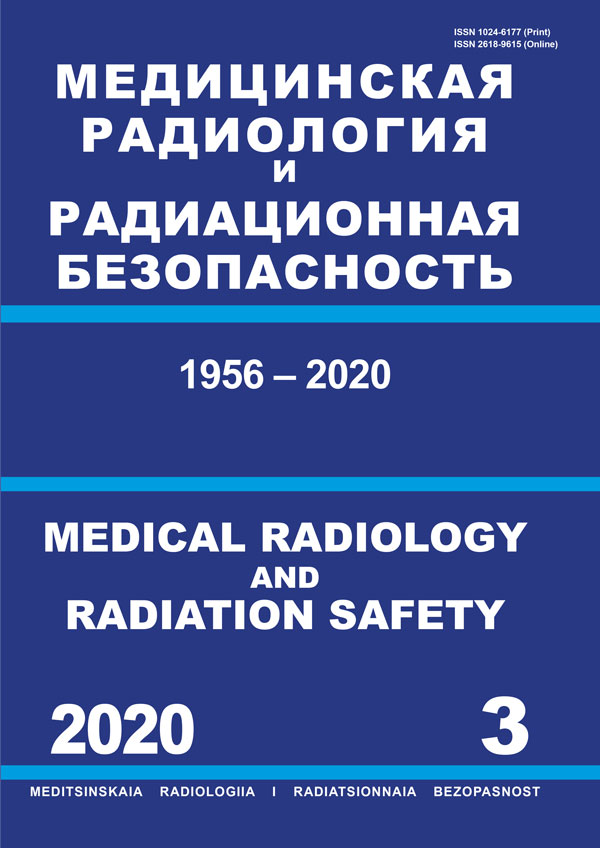Russian Federation
Russian Federation
Russian Federation
Russian Federation
UDC 53
CSCSTI 29.05
CSCSTI 29.15
CSCSTI 59.37
Russian Classification of Professions by Education 14.04.02
Russian Classification of Professions by Education 16.03.01
Russian Classification of Professions by Education 16.06.01
Russian Classification of Professions by Education 30.05.02
Russian Library and Bibliographic Classification 245
Russian Trade and Bibliographic Classification 6136
Russian Trade and Bibliographic Classification 626
BISAC MED080000 Radiology, Radiotherapy & Nuclear Medicine
BISAC SCI009000 Life Sciences / Biophysics
BISAC SCI058000 Radiation
Purpose: Study of physical and chemical properties of radioactive aerosols formed on the fabrication of mixed nitride uranium-plutonium (MNUP) fuel. Material and methods: The following impactors were utilized for activity particle-size distribution analysis: AIP-2, PHRT, IRAM-2-4I (SRC FMBC), Andersen cascade impactor (Copley Scientific, UK), SKC Sioutas (SKC inc., USA). Scanning electron microscope (SEM) Tescan LYRA-3 equipped the X-ray microanalyzer X-max 80 (Oxford Instruments) was used for study of morphological characteristics of aerosol particles. Secondary ion-mass spectrometer Cameca IMS-1280 and track analysis were used for search of particles containing the uranium and plutonium radionuclides. Results: Values of AMAD (Σa) vary from 12 µm till 30 µm, for 239Pu – from 14 till 27 µm. Lowest AMAD values (0.4–2.5 µm for 239Pu) were found in the repair area near the glove box of synthesis and sintering. The samples contain a much larger number of uranium-containing particles, which is likely due to a larger mass fraction of uranium oxide compared with plutonium dioxide in the initial mixture of reagents. Elemental composition of aerosol particles includes U (63–86 %), Pu (5–10 %) and О (9–47 %), Fe – in some samples till 32 %. Other elements like Nа, S, N, Р are contained in rather lowest amounts not exceeding 1–8 %. Only one nitrogen-containing particle was found (3 % of N). Conclusion: Coarse fraction of radioactive aerosols makes a major contribution in activity concentration in air of the operator zone which is driven by such operations as pressing and crushing. Aerosol particles are presented as individual particles or dense aggregates by size of 0,2– 2 µm and also as conglomerates by size 0,5–4 µm consisting of oxides (or carbides) of silicon, iron, calcium, etc. containing inclusions (200–400 nm) or individual particles (20–200 nm) of mixed U-Pu oxide or uranium oxide on the surface of conglomerate as well aslocated in the near-surface layers inside.
plutonium, radioactive aerosol, AMAD, impactor, mixed nitride uranium-plutonium fuel, scanning electron microscope
1. Karev AE, Tsovyanov AG, Kukhta BA, Shinkarev SM, Pripachkin DA. Method to estimate a radioactive aerosol particle deposition in the human respiratory tract. Safety and Emergency Issues 2016;5:23-31. (In Russ.).
2. Ogorodnikov BI, Suhoruchkin AK, Budyka AK, et al. Radioactive aerosols of object “Shelter” (review). Part 3. Particle-size distribution of radioactive aerosols. Chernobyl (In Russ.).
3. The origin of the submicron fraction in the results of measurements of the dispersed composition of aerosols of the object “Shelter”: Report GSPChernobyl NPS, inv. TO OY № 364 of 20.12.2002. A.K. Suhoruchkin. Slavutich, 2002. 22 p. (In Russ.).
4. Guidelines 2.6.1.065-2014. Dosimetric control of occupational internal exposure. General requirements (In Russ.).
5. Patent RU 2239815 «Cascadeimpactor» from 10.11.2004. Authors: Tsovyanov AG, Badin VI, Molokanov AA, Pripachkin DA, Rizin AI, Fertman DE. (In Russ.).
6. Patent RU 2509375 «Impactor-phantom of the human respiratory tract» of 10.03.2014. Authors: Tsovyanov AG, Kukhta BA, Karev AE. (In Russ.).
7. Tsovyanov AG, Kramer-Ageev EA, Fertman DE, et al. Impactor-Phantom of Human Respiratory Tract: Numerical Simulation and Design. ANRI 2013(74)52-60. (In Russ.).
8. Karev AE, Shinkarev SM, Tsovyanov AG. Application of Sampling Conventions for Inhalable, Thoracic and Respirable Fractions (GOST R ISO 7708-2006) for Stationary and Individual Control of Volumetric activity of Radioactive Aerosols at the Enterprises of Atomic Industry. ANRI. (In Russ.).
9. Guidelines on control methods 2.6.1.08-2004. Determination of the size distribution characteristics of a radioactive aerosol. (In Russ.).
10. Determination of the size distribution characteristics of a radioactive aerosol using the impactor-phantom of a human respiratory tract (certification certificate № 7-4/25.01.00087-2015 of 07.10.2015. FR.1.31.2016.23130) (In Russ.).
11. Method for measuring the activity of gamma-emitting radionuclides in counting samples using the gamma-spectrometry system LabSOCS. Certificate of Attestation №770/07 of 25.06.2007 (In Russ.).
12. FR.1.40.2013.15390. Method of measuring the specific activity of uranium isotopes (238U, 234U, 235U) in samples of soil, bottom sediments, rocks and building materials based on the alpha-spectrometric method with radiochemical preparation. Moscow. 2013 (In Russ.).
13. FR.1.40.2013.15395. Method for measuring the specific activity of plutonium isotopes (238Pu, 239+240Pu) in samples of soil, bottom sediments, rocks and building materials based on the alpha-spectrometric method with radiochemical preparation, Moscow. 2013 (In Russ.).
14. FR.1.40.2013.15396 Method for measuring the specific activity of americium-241 (241Am) in samples of soil, bottom sediments, rocks and building materials based on the alpha-spectrometric method with radiochemical preparation. Moscow. 2013 (In Russ.).
15. ICRP Database of Dose Coefficients: Worker and Members of the Public. Elsevier. 2001.
16. GOST R 54597-2011. Air working area. Ultrafine aerosols, aerosols of nanoparticles and nanostructured particles. Characterization and evaluation of exposure by inhalation (In Russ.).
17. https://www.skcinc.com/catalog/pdf/instructions/1690.pdf
18. Report on the accomplishment of work a «comprehensive survey of radioactive aerosols of CMP production «SCC» Contact № 27/02-0399 of 28.03.2014. (In Russ.).
19. ICRP Publication 66. Human Respiratory Tract Model for Radiological Protection. Ann. ICRP. 1994;24(1-3).





